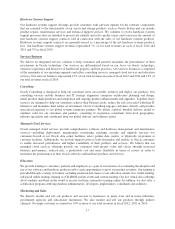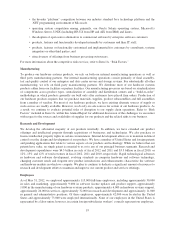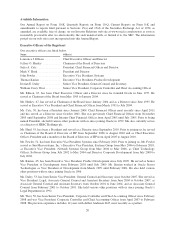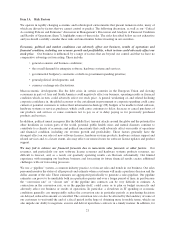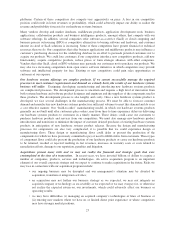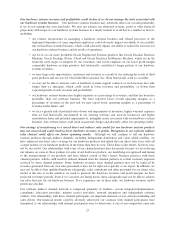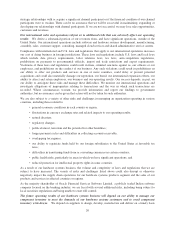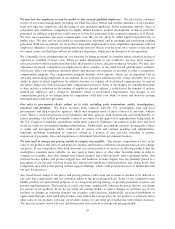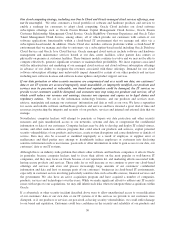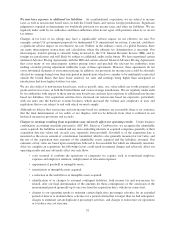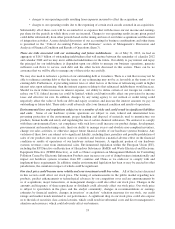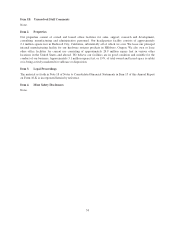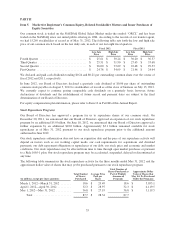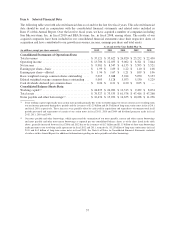Oracle 2012 Annual Report Download - page 31
Download and view the complete annual report
Please find page 31 of the 2012 Oracle annual report below. You can navigate through the pages in the report by either clicking on the pages listed below, or by using the keyword search tool below to find specific information within the annual report.the necessary components for our hardware products. While many of the components purchased are standard,
some components (standard or otherwise) require long lead times to manufacture and deliver. Furthermore, there
are some components that can only be purchased from a single vendor due to price, quality, technology or other
business constraints. As a result, our supply chain operations could be disrupted or negatively impacted by
natural disasters, political unrest or other factors affecting the countries or regions where these single source
component vendors are located. We may be unable to purchase these items from the respective single vendors on
acceptable terms or may experience significant delays or quality issues in the delivery of necessary parts or
components from a particular vendor. If we had to find a new supplier for these parts and components, hardware
systems product shipments could be delayed, which would adversely affect our hardware systems revenues. We
could also experience fluctuations in component prices which, if unanticipated, could negatively impact our
hardware systems business cost structure. These factors may make it difficult for us to plan and procure
appropriate component inventory levels in a timely fashion to meet customer demand for our hardware products.
Therefore we may experience component inventory shortages which may result in production delays or
customers choosing to purchase fewer hardware products from us or systems products from our competitors. We
negotiate supply commitments with vendors early in the manufacturing process to ensure we have sufficient
components for our hardware products to meet anticipated customer demand. We must also manage our levels of
older component inventories used in our hardware products to minimize inventory write-offs or write-downs. If
we have excess inventory, it may be necessary to write-down the inventory, which would adversely affect our
operating results. If one or more of the risks described above occurs, our hardware systems business and related
operating results could be materially and adversely affected.
We expect to continue to depend on third party manufacturers to build certain hardware systems products and
third party logistics providers to deliver our products. As such, we are susceptible to manufacturing and
logistics delays that could prevent us from shipping customer orders on time, if at all, and may result in the
loss of sales and customers. We outsource the manufacturing, assembly and delivery of certain of our
hardware products to a variety of companies, many of which are located outside the United States. Our reliance
on these third parties reduces our control over the manufacturing and delivery process, exposing us to risks,
including reduced control over quality assurance, product costs, product supply and delivery delays as well as the
political and economic uncertainties and natural disasters of the international locations where certain of these
third party manufacturers have facilities and operations. Any manufacturing disruption or logistics delays by
these third parties could impair our ability to fulfill orders for these hardware systems products for extended
periods of time. If we are unable to manage our relationships with these third parties effectively, or if these third
parties experience delays, disruptions, capacity constraints, regulatory issues or quality control problems in their
operations, or fail to meet our future requirements for timely delivery, our ability to ship and/or deliver certain of
our hardware systems products to our customers could be impaired and our hardware systems business could be
harmed.
We have simplified our supply chain processes by reducing the number of third party manufacturing partners and
the number of locations where these third party manufacturers build our hardware systems products. We
therefore have become more dependent on a fewer number of these manufacturing partners and locations. If these
partners experience production problems or delays or cannot meet our demand for products, we may not be able
to find alternate manufacturing sources in a timely or cost effective manner, if at all. If we are required to change
third party manufacturers, our ability to meet our scheduled hardware systems products deliveries to our
customers could be adversely affected, which could cause the loss of sales and existing or potential customers,
delayed revenue recognition or an increase in our hardware systems products expenses, all of which could
adversely affect the margins of our hardware business.
We may experience foreign currency gains and losses. We conduct a significant number of transactions in
currencies other than the U.S. Dollar. Changes in the value of major foreign currencies, particularly the Euro,
Japanese Yen and British Pound relative to the U.S. Dollar can significantly affect our revenues and operating
results. Generally, our revenues and operating results are adversely affected when the dollar strengthens relative
to other currencies and are positively affected when the dollar weakens.
In addition, we incur foreign currency transaction gains and losses, primarily related to sublicense fees and other
intercompany agreements among us and our subsidiaries that we expect to cash settle in the near term, which are
27


